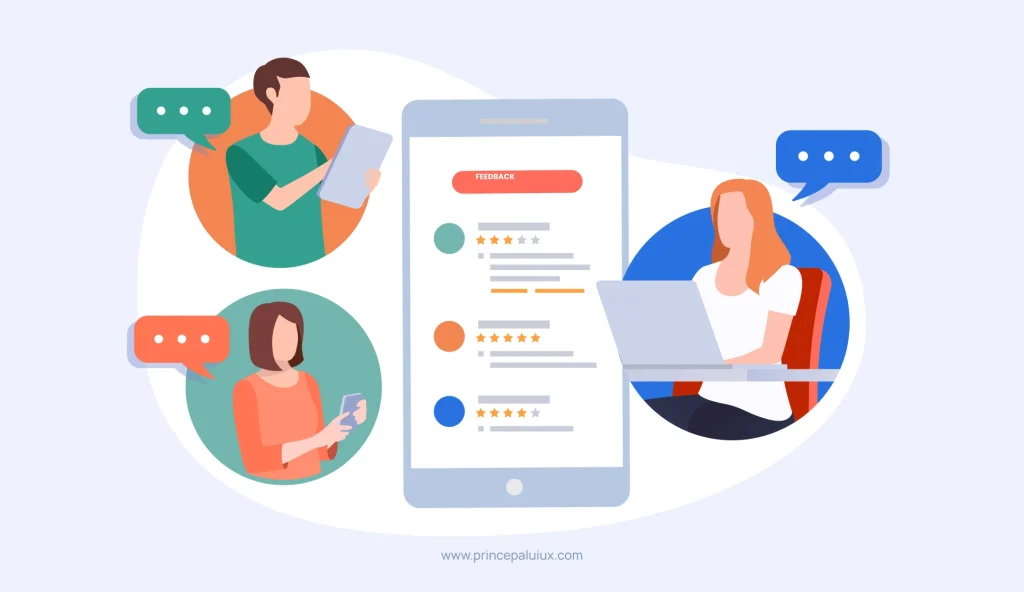The article emphasizes user-centered design and the importance of understanding user behavior, needs, motivations, pain points, unsaid wants, and preferences in SaaS Product Design Success.
It also includes additions about usability, accessibility, inclusivity, and performance optimization.
The main takeaway is that successful design requires empathy and incorporating user insights.
Design is more than aesthetics. It’s about solving real problems by putting users at the heart of every decision.
By understanding their behaviors, needs, and hidden desires, designers can craft solutions that resonate profoundly and drive meaningful outcomes.
Let’s explore how to harness user insights effectively with fresh examples and actionable strategies.
Why Users Are the Cornerstone of SaaS Product Design Success

The user-centered design prioritizes empathy. Designers who focus on real user experiences create functional and delightful products.
Why It Matters:
- Boosts loyalty: Solutions tailored to users foster trust and long-term engagement.
- Sparks innovation: Uncovering unmet needs leads to breakthrough ideas.
- Reduces risk: Validating decisions with real users minimizes costly redesigns.
Example in Action:
A travel booking app noticed users frequently abandoned the checkout process. By analyzing behavior, the team discovered users felt overwhelmed by too many add-on offers. Simplifying the flow increased conversions by 30%.
Breaking Down User-Centric Design Elements
1. Behavior: Decoding User Actions
Behavior reflects how users interact with your product, from clicks to navigation paths.
How to Identify:
- Track drop-off points in workflows (e.g., cart abandonment).
- Monitor feature usage through analytics tools like Hotjar.
Example Insight:
Users of a fitness app often skipped logging meals because the process required manual entry. Introducing a barcode scanner reduced friction and increased daily usage.
Pro Tip: Use session recordings to visualize where users hesitate or backtrack.
2. Needs: Solving Core Problems
Needs are the fundamental goals users aim to achieve.
How to Identify:
- Ask: “What job is the user hiring this product to do?”
- Conduct contextual interviews to observe workflows.
Example Insight:
Freelancers using an invoicing tool needed a way to automate recurring bills. Adding a “duplicate invoice” feature saved them hours monthly.
Pro Tip: Leverage feedback widgets on your platform to capture needs in real-time.
3. Motivations: Understanding the “Why”
Motivations drive user choices, whether practical (speed) or emotional (status).
How to Identify:
- Map user journeys to identify decision triggers.
- Ask: “What made you choose us over alternatives?”
Example Insight:
A budgeting app found users were motivated by gamified savings challenges, not just tracking expenses. Highlighting this feature boosted referrals.
Pro Tip: Run surveys with open-ended questions to uncover emotional drivers.
4. Pain Points: Eliminating Frustrations
Pain points are obstacles that hinder users from achieving their goals.
How to Identify:
- Analyze support tickets for recurring complaints.
- Conduct usability tests to spot confusing UI elements.
Example Insight:
Shoppers on a grocery app struggled to filter products by dietary restrictions. Adding clear allergy-friendly tags reduced customer service inquiries.
Pro Tip: Use tools like UserTesting to observe users’ facial expressions and verbal feedback during tasks.
5. Unsaid Wants: Anticipating Hidden Desires
These are needs users don’t articulate but still expect.
How to Identify:
- Monitor trends in feature adoption (e.g., sudden spike in dark mode usage).
- Analyze competitors to spot emerging expectations.
Example Insight:
Social media users rarely requested “undo send” for messages, but its introduction became a beloved feature across platforms.
Pro Tip: Run A/B tests with “nice-to-have” features to gauge silent demand.
6. Preferences: Aligning with User Tastes
Preferences are design elements users naturally favor, like layout styles or interaction methods.
How to Identify:
- Test variations of CTAs, colors, or navigation structures.
- Review heatmaps to see where users focus their attention.
Example Insight:
A podcast app’s users preferred skipping ads with a swipe gesture rather than a button. Implementing this gesture improved satisfaction scores.
Pro Tip: Use tools like Optimizely for multivariate testing to refine preferences.
Enhancing Usability and Accessibility: Critical Additions
While the original points emphasize user-centric design, they overlook foundational principles of usability and accessibility. Here are key additions to ensure designs are both functional and inclusive:
7. Usability: Designing for Efficiency and Satisfaction
Usability ensures products are intuitive, efficient, and error-tolerant.
Key Principles to Apply:
- Follow Nielsen’s Heuristics:
- Consistency: Maintain uniform UI patterns (e.g., buttons for actions).
- Error Prevention: Use confirmation dialogs for irreversible actions.
- User Control: Allow easy undo/redo options (e.g., Gmail’s “Undo Send”).
- Simplify Navigation: Avoid deep menus; prioritize key tasks on the homepage.
- Optimize Task Flows: Reduce steps for everyday actions (e.g., one-click checkout).
Example Insight:
A SaaS tool reduced user errors by 40% after adding inline validation to forms and more precise error messages.
Pro Tip: Conduct usability tests with metrics like task success rate and time-on-task.
8. Accessibility: Designing for All Abilities
Accessibility ensures products are usable by people with disabilities.
Key Standards to Implement:
- WCAG Compliance: Meet guidelines for contrast ratios (4.5:1 for text), keyboard navigation, and screen reader compatibility.
- Alt Text for Images: Describe visuals for users relying on assistive tools.
- Semantic HTML: Use proper tags (e.g.,
<header>,<nav>) for screen reader clarity.
Example Insight:
Adding keyboard shortcuts to a video streaming app made it navigable for users with motor impairments, increasing engagement by 25%.
Pro Tip: Test accessibility using tools like Axe or WAVE and involve users with disabilities in testing.
9. Inclusive Design: Beyond Basic Accessibility
The inclusive design addresses diverse user contexts, including situational and cultural needs.
Strategies:
- Situational Adaptability: Design for temporary limitations (e.g., captions for noisy environments).
- Cultural Sensitivity: Avoid color symbolism that may vary globally (e.g., red = danger vs. luck).
- Language Flexibility: Offer localization options and plain-language alternatives.
Example Insight:
A global e-commerce site saw higher conversions in Asia after replacing “Add to Cart” with “Buy Now” in regions where instant purchases are preferred.
Pro Tip: Use personas representing diverse abilities, ages, and cultural backgrounds.
10. Responsive & Cross-Device Compatibility
Ensure seamless experiences across devices and screen sizes.
How to Achieve:
- Adopt mobile-first design for critical tasks.
- Test on real devices (e.g., tablets, foldables) to identify layout breaks.
- Use flexible grids and scalable vector graphics (SVGs).
Example Insight:
A news website’s bounce rate dropped by 15% after optimizing article layouts for vertical scrolling on mobile.
Pro Tip: Leverage CSS media queries to adapt content dynamically.
11. Performance Optimization: Speed as a Usability Factor
Slow performance frustrates users and drives abandonment.
Best Practices:
- Compress images and lazy-load non-critical content.
- Minimize JavaScript bloat; prioritize above-the-fold content.
- Monitor load times with tools like Lighthouse.
Example Insight:
Reducing a travel site’s load time from 8s to 2s increased bookings by 20%.
Pro Tip: Set performance budgets (e.g., max page size: 2MB).
12. Feedback & Error Recovery
Empower users to correct mistakes and provide input.
Tactics:
- Offer clear error messages with actionable solutions.
- Include “Contact Support” links in dead-end scenarios.
- Save progress automatically (e.g., Google Docs).
Example Insight:
A banking app introduced a “Save Draft” feature for interrupted loan applications, reducing repeat starts by 30%.
Pro Tip: Use micro-interactions (e.g., checkmarks) to confirm successful actions.
13. Legal & Ethical Considerations
Non-compliance with accessibility laws can lead to lawsuits and reputational damage.
Critical Steps:
- Audit for ADA (Americans with Disabilities Act) and EAA (European Accessibility Act) compliance.
- Document accessibility efforts to demonstrate due diligence.
Example Insight:
A retail giant faced a $6M lawsuit for inaccessible checkout flows but rebuilt trust by publishing an accessibility roadmap.
Pro Tip: Partner with legal teams to stay updated on regional regulations.
Case Study: Usability & Accessibility in Action
Problem: A healthcare app had low adoption among elderly users.
Solutions:
- Increased font sizes and contrast (accessibility).
- Simplified appointment booking to 3 steps (usability).
- Added voice-based navigation (inclusive design).
Outcome: User retention improved by 50%, and 90% of seniors rated the app as “easy to use.”
Final Checklist for Inclusive Design
- Audit for WCAG 2.1 AA compliance.
- Test with screen readers and keyboard-only navigation.
- Optimize load times (<3s).
- Include diverse user groups in testing.
- Document accessibility features for transparency.
By integrating usability and accessibility into every design phase, you create user-centered and universally empowering products.
Combining Insights for Holistic Solutions for SaaS Product Design Success
Integrate all user insights to create cohesive designs:
- Align features with needs: If users value speed, prioritize shortcuts.
- Solve pain points first: Fix critical issues before adding new features.
- Delight with unsaid wants: Surprise users with intuitive additions, like auto-save in a note-taking app.
Example:
A banking app redesigned its transfer process by:
- Simplifying steps (addressing pain points).
- Adding biometric login (meeting preference for security).
- Including a “split bill” feature (anticipating unsaid wants).
Mastering User-Centric SaaS Product Design Success: Pro Tips
- Mix methods: Combine analytics (quantitative) with interviews (qualitative).
- Test early and often: Validate wireframes with prototypes before full development.
- Document everything: Build personas and empathy maps to keep teams aligned.
- Stay curious: Regularly revisit user data—needs to evolve.
Conclusion
As designer Frank Chimero once said, “People ignore design that ignores people.” By embedding user insights into every design decision, you create solutions that are not just usable, but unforgettable. Start small—pick one element from this guide, apply it, and watch how empathy transforms your work.
Let’s design with purpose.
